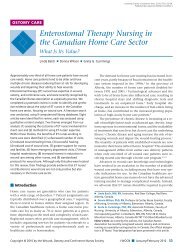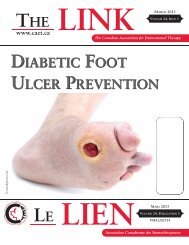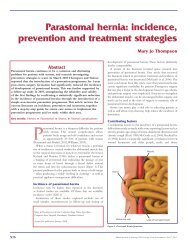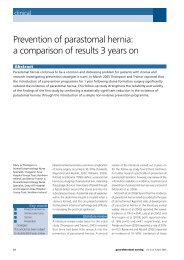Incidence of parastomal hernia before and after a prevention ...
Incidence of parastomal hernia before and after a prevention ...
Incidence of parastomal hernia before and after a prevention ...
You also want an ePaper? Increase the reach of your titles
YUMPU automatically turns print PDFs into web optimized ePapers that Google loves.
clinical<br />
Figure 5<br />
15<br />
12<br />
9<br />
6<br />
3<br />
0<br />
Figure 6<br />
15<br />
12<br />
9<br />
6<br />
3<br />
0<br />
1-20 yrs<br />
colostomy<br />
<strong>and</strong> Swan 2001; Raymond <strong>and</strong> Abulafi 2002)<br />
(Figure 3). In Year 2, following the introduction<br />
<strong>of</strong> the programme, the incidence <strong>of</strong> <strong>parastomal</strong><br />
<strong>hernia</strong>s development dropped to 14 per cent<br />
(n=16) (Figure 4). A Chi square significance<br />
test revealed a p value <strong>of</strong> p≤ 0.025 indicating<br />
that the introduction <strong>of</strong> the programme had<br />
a statistically significant effect in reducing the<br />
incidence <strong>of</strong> <strong>parastomal</strong> <strong>hernia</strong> development.<br />
In Year 1, 65 per cent <strong>of</strong> patients had their<br />
stomas sited pre-operatively <strong>and</strong> emergency<br />
surgery was carried out in 39 per cent. When<br />
the emergency surgery patients were analysed it<br />
was noted that 11 <strong>of</strong> these patients developed<br />
a <strong>parastomal</strong> <strong>hernia</strong> representing an incidence<br />
<strong>of</strong> 33 per cent. Those who had elective surgery<br />
Comparison <strong>of</strong> distribution <strong>of</strong> <strong>parastomal</strong> <strong>hernia</strong> according<br />
to stoma type<br />
illeostomy<br />
Urostomy<br />
Comparison <strong>of</strong> age distribution amidst patients who<br />
developed <strong>parastomal</strong> <strong>hernia</strong> within Years 1 <strong>and</strong> 2<br />
21-40 Yrs<br />
41-60 Yrs<br />
61-80 Yrs<br />
81+ Yrs<br />
<strong>and</strong> developed a <strong>parastomal</strong> <strong>hernia</strong> represented<br />
an incidence <strong>of</strong> 24 per cent.<br />
In Year 2, the same percentage <strong>of</strong> patients<br />
had their stomas sited pre-operatively (65 per<br />
cent) <strong>and</strong> the percentage underwent emergency<br />
surgery (39 per cent). When the emergency<br />
surgery patients who developed <strong>parastomal</strong><br />
<strong>hernia</strong>s in Year 2 were analysed, it was shown<br />
that six <strong>of</strong> these developed a <strong>parastomal</strong> <strong>hernia</strong><br />
representing an incidence <strong>of</strong> 15 per cent.<br />
Those who had elective surgery <strong>and</strong> developed<br />
a <strong>parastomal</strong> <strong>hernia</strong> represented an incidence<br />
<strong>of</strong> 13 per cent. These figures are almost halved<br />
from Year 1 for emergency <strong>and</strong> elective surgery<br />
following the introduction <strong>of</strong> the programme.<br />
This suggests that whether the surgery was<br />
elective or an emergency there was no difference<br />
in terms <strong>of</strong> the incidence <strong>of</strong> <strong>parastomal</strong><br />
<strong>hernia</strong> development.<br />
The significance <strong>of</strong> these findings is the<br />
reduced number <strong>of</strong> patients with <strong>parastomal</strong><br />
<strong>hernia</strong>s who had undergone emergency surgery<br />
(a drop <strong>of</strong> 33 per cent in Year 1 to 15 per cent<br />
in Year 2). This suggests that the introduction<br />
<strong>of</strong> the programme did make a difference to<br />
the overall incidence <strong>of</strong> <strong>hernia</strong> development.<br />
These findings also suggest that the siting <strong>of</strong><br />
stomas has no effect on the development <strong>of</strong><br />
<strong>parastomal</strong> <strong>hernia</strong>, an observation supported<br />
by Carne et al (2003).<br />
When the distribution for incidence <strong>of</strong><br />
<strong>parastomal</strong> <strong>hernia</strong> was analysed according<br />
to stoma type, we can see that in Year 1, 12<br />
<strong>of</strong> the 24 patients had a sigmoid colostomy,<br />
one had transverse colostomy, nine had an<br />
ileostomy <strong>and</strong> two had a urostomy. In Year<br />
2 (n=16), nine patients had a colostomy, six<br />
ileostomy <strong>and</strong> one urostomy.<br />
Although patients with colostomies from<br />
a prima-facia point <strong>of</strong> view appeared to be<br />
more prone to the development <strong>of</strong> <strong>parastomal</strong><br />
<strong>hernia</strong>s (Figure 5), Chi -square analysis did not<br />
demonstrate statistical significance (p=0.06),<br />
suggesting that the type <strong>of</strong> stoma was irrelevant<br />
<strong>and</strong> that each carried an equal risk <strong>of</strong><br />
<strong>parastomal</strong> <strong>hernia</strong> development. Nevertheless,<br />
subtle trends can be seen suggesting that<br />
patients with colostomies are more prone<br />
to <strong>hernia</strong> development. This is supported by<br />
that <strong>of</strong> Carne et al (2003) who found that<br />
<strong>parastomal</strong> <strong>hernia</strong> affects 1.8 - 28.3 per cent<br />
26 gastrointestinal nursing Vol 3 No 2 March 2005<br />
year 1<br />
year 2<br />
year 1<br />
year 2














